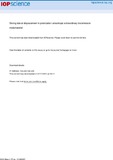Mostrar el registro sencillo del ítem
Strong lateral displacement in polarization anisotropic extraordinary transmission metamaterial
| dc.creator | Beruete Díaz, Miguel | es_ES |
| dc.creator | Navarro Cía, Miguel | es_ES |
| dc.creator | Sorolla Ayza, Mario | es_ES |
| dc.date.accessioned | 2014-06-05T11:29:06Z | |
| dc.date.available | 2014-06-05T11:29:06Z | |
| dc.date.issued | 2010 | |
| dc.identifier.issn | 1367-2630 | |
| dc.identifier.other | 637 | |
| dc.identifier.uri | https://hdl.handle.net/2454/10770 | |
| dc.description | UPNa. Departamento de Ingeniería Eléctrica y Electrónica. Laboratorio de Ondas Milimétricas y Terahercios | es_ES |
| dc.description.abstract | In this paper, a deep numerical as well as experimental study of the anisotropy response of extraordinary transmission metamaterials constructed by stacking subwavelength hole arrays is presented. Two-dimensional (2D) dispersion diagrams for S- and P-polarization were obtained from simulation. From them, it was found that negative refraction can be obtained for the latter case for small angles of incidence. Additionally, it was found that double periodic and dielectric loaded hole arrays are optimal to enlarge the numerical aperture that leads to negative refraction. Several experiments are then presented in the V-band of the millimetre-wave range that show excellent agreement with the numerical calculations. Moreover, the richness of the anisotropic characteristic exhibited by the stacked hole array structure allows for designing structures with complex electromagnetic response other than solely negative refraction. Thus, the results presented here could be taken as a novel route to achieve exotic behaviour, such as negative refraction at other frequency ranges, like terahertz or the visible. | en |
| dc.description.sponsorship | This work was supported by the Spanish Government under the contract Consolider "Engineering Metamaterials" CSD2008-00066. | en |
| dc.format.mimetype | application/pdf | en |
| dc.language.iso | eng | en |
| dc.publisher | IOP Publishing Ltd | en |
| dc.relation.ispartof | New Journal of Physics, 12 (2010) 063037 (15 pgs.) | en |
| dc.rights | © IOP Publishing Ltd and Deutsche Physikalische Gesellschaft. CC Attribution-NonCommercial-ShareAlike 4.0 International (CC BY-NC-SA 4.0) | en |
| dc.rights.uri | https://creativecommons.org/licenses/by-nc-sa/4.0/ | |
| dc.subject | Subwavelength hole arrays | en |
| dc.subject | Negative index metamaterials | en |
| dc.subject | Optical transmission | en |
| dc.subject | Handed metamaterials | en |
| dc.subject | Refraction | en |
| dc.subject | Media | en |
| dc.subject | Lens | en |
| dc.title | Strong lateral displacement in polarization anisotropic extraordinary transmission metamaterial | en |
| dc.type | Artículo / Artikulua | es |
| dc.type | info:eu-repo/semantics/article | en |
| dc.contributor.department | Ingeniería Eléctrica y Electrónica | es_ES |
| dc.contributor.department | Ingeniaritza Elektrikoa eta Elektronikoa | eu |
| dc.rights.accessRights | Acceso abierto / Sarbide irekia | es |
| dc.rights.accessRights | info:eu-repo/semantics/openAccess | en |
| dc.identifier.doi | 10.1088/1367-2630/12/6/063037 | |
| dc.relation.publisherversion | https://dx.doi.org/10.1088/1367-2630/12/6/063037 | |
| dc.type.version | Versión publicada / Argitaratu den bertsioa | es |
| dc.type.version | info:eu-repo/semantics/publishedVersion | en |



